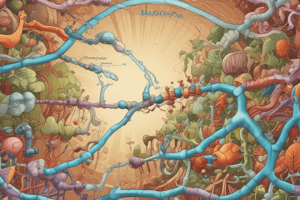Podcast
Questions and Answers
¿Cuál es la enzima responsable de catalizar la primera reacción de la glucólisis convirtiendo glucosa en glucosa-6-fosfato?
¿Cuál es la enzima responsable de catalizar la primera reacción de la glucólisis convirtiendo glucosa en glucosa-6-fosfato?
- Hexoquinasa (correct)
- Fosfofructoquinasa (PFK)
- Isomerasa de fosfofructoquinasa
- Isomerasa de triosa fosfato
¿Qué hormona estimula la captación de glucosa por las células promoviendo la glucólisis?
¿Qué hormona estimula la captación de glucosa por las células promoviendo la glucólisis?
- Adrenalina
- Glucagón
- Insulina (correct)
- Cortisol
¿Cuál de las siguientes enzimas cataliza la conversión de fructosa-1,6-bifosfato en fructosa-6-fosfato en la glucólisis?
¿Cuál de las siguientes enzimas cataliza la conversión de fructosa-1,6-bifosfato en fructosa-6-fosfato en la glucólisis?
- Fosfofructoquinasa (PFK)
- Isomerasa triosa fosfato
- Isomerasa fosfofructoquinasa (correct)
- Hexoquinasa
¿Qué hormona estimula la producción de glucosa en el hígado, inhibiendo la glucólisis?
¿Qué hormona estimula la producción de glucosa en el hígado, inhibiendo la glucólisis?
¿En qué parte de la célula tiene lugar la glucólisis?
¿En qué parte de la célula tiene lugar la glucólisis?
¿Cuál de los siguientes enunciados describe mejor a los inhibidores alostéricos de la glucólisis?
¿Cuál de los siguientes enunciados describe mejor a los inhibidores alostéricos de la glucólisis?
¿Cuál de las siguientes afirmaciones es correcta sobre la regulación de la vía glucolítica en condiciones anaeróbicas?
¿Cuál de las siguientes afirmaciones es correcta sobre la regulación de la vía glucolítica en condiciones anaeróbicas?
¿Cuál es el efecto del fructosa-2,6-bifosfato como regulador alostérico en la glucólisis?
¿Cuál es el efecto del fructosa-2,6-bifosfato como regulador alostérico en la glucólisis?
¿Cuál es uno de los principales roles de la glucólisis bajo condiciones anaeróbicas?
¿Cuál es uno de los principales roles de la glucólisis bajo condiciones anaeróbicas?
¿Cómo se regula la actividad de las enzimas glucolíticas en condiciones aeróbicas?
¿Cómo se regula la actividad de las enzimas glucolíticas en condiciones aeróbicas?
Flashcards are hidden until you start studying
Study Notes
Glycolysis is a metabolic process that takes place in the cytoplasm of cells, breaking down glucose (a six-carbon sugar) into two molecules of pyruvate (a three-carbon compound). This process is essential for cellular respiration, and it is regulated by enzymes, hormones, and various factors. In this article, we will explore the regulation of glycolysis, focusing on enzymes, hormonal regulation, inhibitors, and the regulation of the glycolytic pathway under aerobic and anaerobic conditions.
Enzymes Regulating Glycolysis
Glycolysis is a complex process involving several enzymes. These enzymes are responsible for catalyzing specific reactions in the pathway. Some of the key enzymes include:
- Hexokinase: This enzyme catalyzes the first step of glycolysis, converting glucose into glucose-6-phosphate.
- Phosphofructokinase (PFK): This enzyme is responsible for the second reaction in glycolysis, converting glucose-6-phosphate into fructose-1,6-bisphosphate.
- Triose phosphate isomerase: This enzyme catalyzes the conversion of glyceraldehyde-3-phosphate into dihydroxyacetone phosphate.
Hormonal Regulation of Glycolysis
Hormones play a crucial role in regulating glycolysis. For example, insulin is a hormone that stimulates glucose uptake by cells, promoting glycolysis. Conversely, glucagon is a hormone that stimulates glucose production in the liver, inhibiting glycolysis.
Inhibitors of Glycolysis
There are several inhibitors of glycolysis, which can be classified into two categories: allosteric regulators and end-product inhibitors.
- Allosteric regulators: These inhibitors bind to an enzyme's active site, changing its shape and reducing its activity. For example, fructose-2,6-bisphosphate is an allosteric activator of PFK, while adenosine diphosphate (ADP) is an allosteric inhibitor.
- End-product inhibitors: These inhibitors accumulate as a result of glycolysis and inhibit the activity of glycolytic enzymes. For example, pyruvate, the end product of glycolysis, can inhibit the activity of hexokinase.
Regulation of the Glycolytic Pathway in Aerobic Conditions
Under aerobic conditions (i.e., in the presence of oxygen), glycolysis is regulated to maintain cellular energy homeostasis. In this state, glycolysis is activated when glucose levels are high and inactivated when glucose levels are low.
Regulation of the Glycolytic Pathway in Anaerobic Conditions
Under anaerobic conditions (i.e., in the absence of oxygen), glycolysis is the primary source of ATP production. However, under these conditions, the production of pyruvate is limited due to the lack of oxygen for oxidative phosphorylation. This results in a shift in the regulation of glycolysis, with a greater emphasis on maintaining ATP production and reducing ATP consumption.
In conclusion, glycolysis is a complex metabolic process that is essential for cellular respiration. It is regulated by enzymes, hormones, and inhibitors, and its regulation varies under aerobic and anaerobic conditions. Understanding the regulation of glycolysis is crucial for understanding cellular metabolism and its role in maintaining cellular energy homeostasis.
Studying That Suits You
Use AI to generate personalized quizzes and flashcards to suit your learning preferences.



